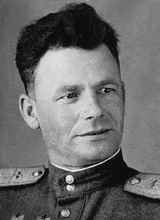Soviet Union

Polkovnik Vakkh Petrovich Teplyakov
Soviet Union

Polkovnik Vakkh Petrovich Teplyakov

1905 –
In late November 1939, 38 IAP was split in two parts, commanded by mayor N. T. Syusyukalov (1st and 4th eskadrilyas in in Pushkin/I-16 and I-15bis, and Vyskatka/I-15bis) and mayor Tikhon Ledenev (2nd and 3rd eskadrilyas in Pushkin; I-16 and I-153) respectively.
In December 1939, 38 IAP was completely reorganized: mayor Tikhon Ledenev’s part became a pure I-153 unit attached to polkovnik G. K. Kravchenko’s OAB in Estonia, while mayor Syusyukalov’s eskadrilyas were split up and dispatched in various directions.
On 16 December, mayor Tikhon Ledenev was ordered to relocate (with I-153s only) to OAB in Sinalepa, Kuusiku (Rapla) and Klooga (near Paldiski), Estonia.
Two days later the fighters took off from Estonia. Additional I-153s were received from 3rd and 4th eskadrilyas of 25 IAP, the latter eskadrilya arrived in Estonia from 21 January 1940.
On 4 January 1940, 4th eskadrilya of 43 IAP and on 12 January, 4th eskadrilya of 2 IAP arrived with 15 I-153s each (both from VVS KOVO), which formed 1st and 2nd eskadrilyas of 38 IAP.
Base location at Klooga enabled bomber escort to southern Finland, However, after heavy bomber losses at Tampere-Hämeenlinna, the I-153 were equipped with under-wing fuel tanks, which considerable increased safe escort range.
Mayor Tikhon Ledenev commanded this reformed 38 IAP.
The LLv 26’s pilots entered in combat for the first time with Gladiators on 2 February 1940.
At 10:40, luutnantti Paavo Berg was engaged in combat with a reported six I-153s above Hanko and shot down one of them.
38 IAP reported that they attacked Turku AF base and kapitan Teplyakov claimed two Bulldogs in combat. Three more Bulldogs were claimed as shared destroyed on the ground by kapitan Tepylakov, kapitan Sergeyev and starshiy leytenant Ivanov.
Jorma “Joppe” Karhunen described Berg’s first claim during the Winter War (Karhunen was at the time a Fokker D.XXI pilot and flight commander in 1/LLv 24):
"We shared the ice base at Littoinen near Turku in the beginning of February 1940. LLv 26’s Gladiators were flown here after they had been assembled in Sweden.Berg’s own combat report was quite short:
On the 2nd of February I saw Berg climbing from Littoinen in GL-263. Air raid sirens were screaming in Turku. Time passed and I saw Berg land. He ran toward me and told me:
"I shot down a Chaika (Polikarpov I-153), it crashed on the ice. My own aircraft has hits, can you borrow me a Fokker so I can go and have a look at the wreck?"
As he was very excited about his first kill, I gave him my permission to use one of our Fokkers. Berg took off and returned after some time. Unfortunately he had damaged the Fokkers undercarriage making a harsh landing on the ice, so the Fokker had to be repaired at the state aircraft factory at Tampere overnight."
“A squadron of Chaikas bounced me from the above. I received several hits on my Gladiator, but a fast evasive turn prevented any further damage. I decided to test the manoeuvrability of my new mount and the nearest three-plane Chaika section wanted to fight with me. The rest of them went away.Berg’s victim was I-153 c/n 6469 from 38 IAP flown by starshiy leytenant N. I. Bedarev (originally from 4./25 IAP), who was taken POW.
The Chaikas made a tight turn to try finishing me off again. I made a turn too and I discovered that my GL was able to turn with the Chaikas. I was not even warmed up when I was able to get into a firing position behind one of them. I tightened my turn to the extreme and thus I was able to pull enough deflection and my short burst hit his engine.
The plane I fired on went down towards the ice. His comrades decided to turn for home, and my victim made a landing on the ice. It looked only slightly damaged. I decided to fly back to Littoinen because I feared the hits on my own aircraft might be critical.”
On22 February 1941, he was decorated with the Order of the Red Star.
When Germany invaded the Soviet Union on 22 June 1941, mayor Teplyakov still served in 38 IAP with I-153s.
Teplyakov left 38 IAP in September 1941 and in January 1942, he was posted to 516 IAP.
He left 516 IAP already in February 1942 and in April 1942, he was posted to 20 IAP.
In February 1943, he left 20 IAP and was posted to the HQ of 309 IAD where he remained until the end of the war.
On 6 September 1943, he was decorated with the Order of the Patriotic War 2nd Class.
He was decorated with the Order of the Patriotic War 1st Class on 24 October 1944.
On 3 November, he was decorated with a second Order of the Red Star.
He was decorated with a second Order of the Patriotic War 2nd Class on 31 May 1945.
Teplyakov ended the war with 2 biplane victories and a total of 3.
These had been claimed during 27 combat missions and 5 air combats.
Claims:
| Kill no. | Date | Time | Number | Type | Result | Plane type | Serial no. | Locality | Unit |
| 1940 | |||||||||
| 1 | 02/02/40 | 10:40 | 1 | Bulldog (a) | Destroyed | I-153 | Turku AF base | 38 IAP | |
| 2 | 02/02/40 | 10:40 | 1 | Bulldog (a) | Destroyed | I-153 | Turku AF base | 38 IAP | |
| 02/02/40 | 10:40 | 1/3 | Bulldog (a) | Shared destroyed on the ground | I-153 | Turku AF base | 38 IAP | ||
| 02/02/40 | 10:40 | 1/3 | Bulldog (a) | Shared destroyed on the ground | I-153 | Turku AF base | 38 IAP | ||
| 02/02/40 | 10:40 | 1/3 | Bulldog (a) | Shared destroyed on the ground | I-153 | Turku AF base | 38 IAP | ||
| 1942 | |||||||||
| 3 | 10/12/42 | 1 | Hs 126 | Destroyed | Yak-7B | Western Front | 20 IAP |
Biplane victories: 2 destroyed, 3 shared destroyed on the ground.
TOTAL: 3 destroyed, 3 shared destroyed on the ground.
(a) Not verified with Finnish records.
Sources:
All aces of Stalin 1936-1953 – Mikhail Bykov, 2014
Talvisota Ilmassa - The Winter War In the Air - Carl-Fredrik Geust, 2011 Apali Oy, Tampere, ISBN 978-952-5877-04-5
Soviet Aces 1936-1953
Soviet Fighter Pilots 1936-1953 - Mikhail Bykov
Red Stars 7 - Suomen Ilmavoimat part II – 1928-40 – Kalevi Keskinen and Kari Stenman, 2006, ISBN 952-99743-0-2


